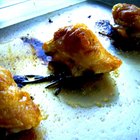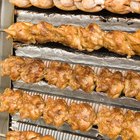
Chicken is most often roasted with the breasts facing up, which leaves the wing tips pointing straight up instead of tucked neatly under the bird. The wings are much smaller than any other part of the chicken, which means the tips are likely to burn long before the rest of the chicken reaches an internal temperature of 165 degrees Fahrenheit. When the wings are tucked, it not only helps prevent burning, but also makes the presentation more attractive.
Step 1
Season the whole chicken as desired. Brush olive oil all over the skin or rub softened butter over the chicken. Sprinkle with your choice of spices, such as salt and pepper or a poultry seasoning blend. Place the chicken in a roasting pan with the breasts facing up.
Step 2
Turn the roasting pan so the neck and wings end is facing toward you. Pull a wing tip toward your body with your fingers, straightening the wing at its joint. Push the tips down toward the neck cavity and work surface.
Step 3
Lift up on the front of the chicken slightly and slide the wing tip under the neck to hold it in place. The wings should bend back to their original shape at the joints, though they're now under the chicken and you can't see them.
Related Articles

How to Marinate BBQ Chicken Thighs & ...

How to Cook Chicken Thighs

How to Cook Chicken Bratwurst

The Proper Way to Inject Marinade Into ...

How to Cook Chicken Wings by Boiling ...

How to Cook a Neck Roast

How Long Do You Need to Boil Large ...

How to Re-Crisp a Cold Roast Chicken

How to Cook a Flat Chicken

How to Cook Barbecue Chicken Drumsticks ...

How to Cook BBQ Wings on a Gas Grill

How to Defrost a Chicken in a ...

How to Tie a Rotisserie Chicken

How to Tie a Zipper Tie

How to Cook Chicken Legs With Italian ...

How to Cook Meat Shish Kabobs on an ...

How Do I Make Baked Boneless Chicken ...

How to Grill Boneless Chicken Strips

How to Broil Chicken on the Bone

How to Make Crock-pot Chicken
References
Tips
- It's also common to tie the chicken legs together around the rear cavity of the chicken. You simply pull the ends of the legs together and slip butcher's twine around the ends to hold the legs in place.
Writer Bio
A former cake decorator and competitive horticulturist, Amelia Allonsy is most at home in the kitchen or with her hands in the dirt. She received her Bachelor's degree from West Virginia University. Her work has been published in the San Francisco Chronicle and on other websites.
Photo Credits
David De Lossy/Photodisc/Getty Images